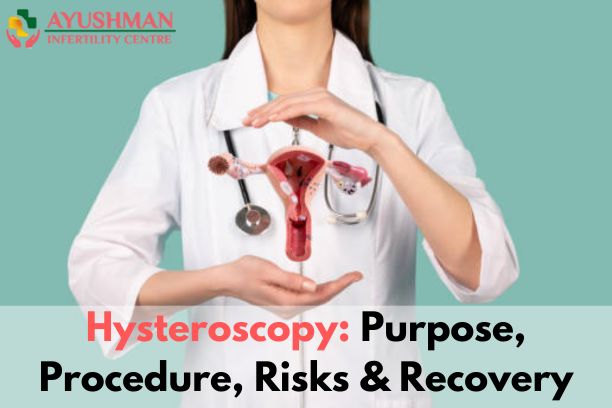
Hysteroscopy: Purpose, Procedure, Risks & Recovery
The female body is a marvel of intricate systems, and the uterus plays a vital role in reproductive health. When concerns arise regarding abnormal uterine bleeding, fibroids, or other internal issues, a hysteroscopy emerges as a powerful diagnostic and treatment tool. This guide delves into the world of hysteroscopy, exploring its purpose, procedures, recovery, and everything in between.
What is Hysteroscopy?
Imagine a thin, lighted tube equipped with a camera – that’s the hysteroscope, your window into the uterine cavity. During the procedure, this instrument is inserted through the vagina and cervix, allowing your doctor to examine the uterine lining and pinpoint potential abnormalities.
The Two Faces of Hysteroscopy: Diagnosis and Treatment
Hysteroscopy offers a two-pronged approach to uterine health concerns. It can be performed for:
- Diagnostic Hysteroscopy: This procedure acts as a detective, enabling your doctor to identify the cause of abnormal bleeding, evaluate the uterine lining, and confirm findings from other tests like ultrasound or HSG (hysterosalpingography).
- Operative Hysteroscopy: Here, the hysteroscope becomes a surgical tool. Your doctor can remove polyps, fibroids, scar tissue (adhesions), or uterine septum (a malformation) through the hysteroscope, offering a minimally invasive solution.
Why Might You Need a Hysteroscopy?
Hysteroscopy addresses a spectrum of uterine concerns, including:
- Abnormal uterine bleeding: Heavy menstrual periods, irregular spotting, or postmenopausal bleeding can all be investigated.
- Polyps and fibroids: These growths within the uterus can be visualized and removed.
- Adhesions (Asherman’s syndrome): Scar tissue impacting menstrual flow and fertility can be identified and addressed.
- Uterine septum: This malformation can be diagnosed.
- Fertility issues: The cause of repeated miscarriages or fertility problems can be explored.
- IUD placement or removal: Locate an intrauterine device (IUD) or remove retained placental tissue after childbirth.
Who is a Suitable Candidate?
While highly beneficial, hysteroscopy isn’t for everyone. If you’re pregnant or have a pelvic infection, this procedure might not be recommended. Your doctor will assess your situation to determine the best course of action.
Preparing for the Procedure: What to Expect
The timing of your hysteroscopy will depend on your menstrual cycle. Ideally, it’s scheduled for the first week after your period ends for optimal visualization. Your doctor will provide detailed instructions, which may include:
- Discuss your medical history and medications.
- Performing a physical exam, pelvic exam, and pregnancy test.
- Informing you about fasting requirements and transportation arrangements post-procedure.
What happens during a hysteroscopy?
On the day of your hysteroscopy, you’ll likely receive anesthesia or sedation for comfort. Here’s a breakdown of the procedure:
- Positioning: You’ll be comfortably positioned on an examination table.
- Pelvic Exam: A routine pelvic exam is performed.
- Cervical Dilation: The cervix is gently dilated to allow for the hysteroscope insertion.
- Hysteroscope Insertion: The hysteroscope is introduced through the vagina and cervix into the uterus.
- Fluid Instillation: A sterile fluid is used to expand the uterus for better visualization.
- Examination and Potential Treatment: The doctor examines the uterine cavity and fallopian tube openings. If necessary, surgical instruments are inserted through the hysteroscope to remove abnormalities.
The duration of the procedure can vary from five minutes to an hour, depending on whether it’s diagnostic or operative and if additional procedures are combined.
How long does it take to recover from hysteroscopy?
Following your hysteroscopy, you might experience cramping or light bleeding for a few days. Feeling faint or slightly nauseous is also common.
- Hospital Stay: Hysteroscopy is usually an outpatient procedure, and you likely won’t require an overnight stay. However, this might depend on your situation and the doctor’s discretion.
- Recovery Time: The recovery timeline depends on the extent of the procedure. Your doctor will provide specific guidelines regarding activities to avoid, such as douching, intercourse, or using tampons, for a designated period.
When to Seek Medical Attention?
Be sure to contact your doctor if you experience any concerning symptoms post-procedure, such as:
- Fever
- Severe abdominal pain
- Heavy vaginal bleeding
FAQs About Hysteroscopy
Q: How painful is a hysteroscopy?
A: Pain perception is subjective. While some experience minimal discomfort, others might feel cramping or pinching. Talk to your doctor about pain management options and the type of anesthesia you’ll receive.
Q: Am I awake during a hysteroscopy?
A: Anesthesia options include local, regional, or general anesthesia. Local numbs a small area, regional numbs a larger area, and general anesthesia puts you to sleep. Your doctor will recommend the most suitable option based on your needs.
Q: Is hysteroscopy a major surgery?
A: No, hysteroscopy, particularly operative hysteroscopy, is considered minor surgery. It’s minimally invasive and doesn’t require a lengthy hospital stay.
Q: Is a D&C (dilation and curettage) the same as a hysteroscopy?
A: Both procedures remove uterine tissue. However, a hysteroscopy allows for visualization and precise removal of growths using surgical instruments. A D&C involves scraping the uterine lining to collect a tissue sample for analysis.
Q: Should I be worried about hysteroscopy?
A: Hysteroscopy is a safe procedure with minimal risks. Open communication with your doctor can address any anxieties you might have.
Final Note
Hysteroscopy empowers you and your doctor to investigate and address uterine concerns. By understanding the procedure, its benefits, and the recovery process, you can approach your hysteroscopy with confidence. Remember, clear communication with your doctor is key to a smooth experience. Don’t hesitate to ask questions and voice any anxieties you may have.
Leave a reply
Leave a reply